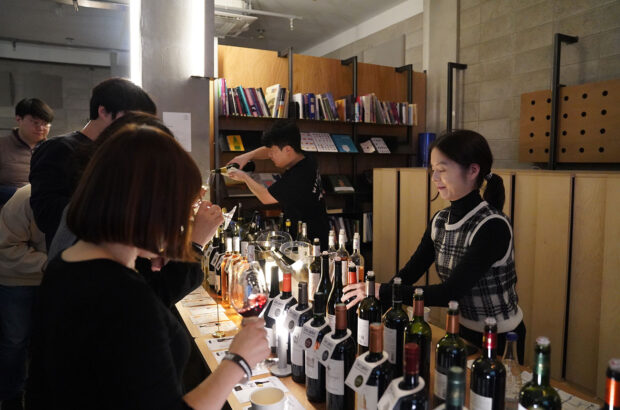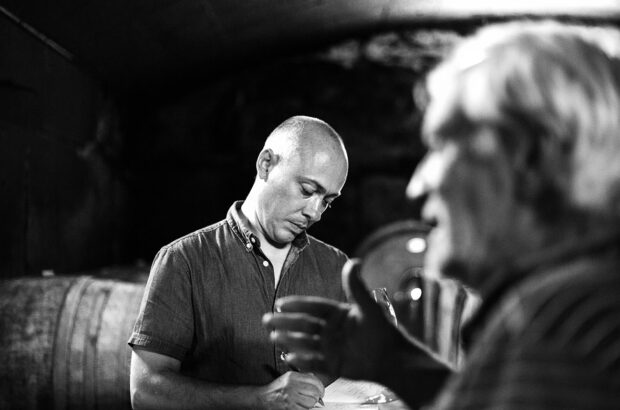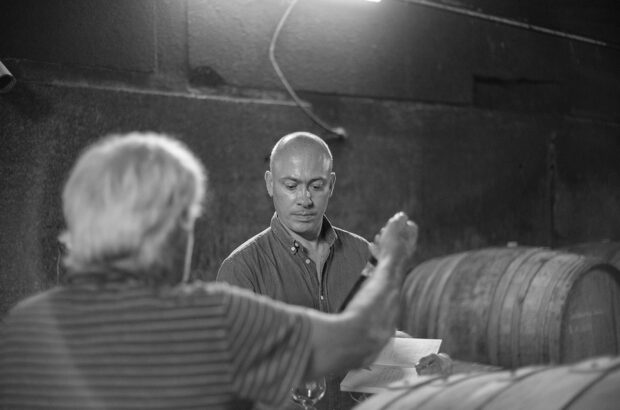Forceful, ebullient, ruddy, hale, perhaps abrasive: that's what you'd expect of a former rugby international turned wine merchant.
Gérard Bertrand (Image: Andrew Jefford)
Gérard Bertrand is none of these things. He’s watchful, attentive, graceful, almost feline (panther rather than tabby). Very good on detail, very penetrating; alert to the reactions and responses of others. Doubtless demanding: I could see him grinding problems and challenges into oblivion, via emails dispatched in the small hours from distant hotel rooms. Intelligence and ambition, though, have served him well: a turnover of 65 million euros, and some 600 ha of vineyard scattered over 10 wine estates in most of the best zones of the Languedoc. He’ll be 50 next year. So now, the time has come to …
Well, the wines he mentioned were Vega Sicilia 1947, Romanée-Conti 1961 and Latour 1961. No, I’ve never tasted any of them either, but he had enjoyed them on his travels; they’d set him dreaming. “I want to make a wine you can drink in 40 years,” he confessed. ”I want to demonstrate that in Languedoc-Roussillon you can do the same thing.” Reach for the stars: why not? But Languedoc-Roussillon is vast. So where?
I might have poked about in Pic St Loup, Terrasses du Larzac, St Chinian or the Agly valley. Gérard Bertrand, though, who knows the Languedoc much more intimately than I do, had seen a hauntingly beautiful vineyard in Minervois-La Livinière back in 1997. He came to think he could do it there. He wanted to amplify the vineyard plantings, and then the newer vines needed 12 years’ age, so its fruit has been dispatched elsewhere thus far. With the 2012 vintage, though, he felt the time had come to launch his starship wine, which he is calling Clos d’Ora.
The 9 ha of this vineyard lie abreast of a hill between 192 m and 220 m: high, cool, airy, with big diurnal temperature differences of 20˚C or more. “The idea,” he remembers, “was to make a very interesting wine of the South of France at altitude.” There’s a geological fault there; the terraced south side has sandstone and clay soils, while the gently rising north side, which gazes across to the Montagne Noire, is limestone rubble. He’s planted young Mourvèdre to keep the old-vine Carignan company on the south side, whereas the north side has 40-year-old Syrah and 25-year-old bush-vine Grenache, to which he has added more Syrah and some trellised Grenache (to bring out different fruit qualities). And all biodynamically grown, and mule-ploughed. Bertand claims that homeopathy “changed my life” — by resolving a liver issue that stopped him drinking wine
— and he has become a convinced biodynamic practitioner. From next year, the Bertrand domains will have no less than 350 ha grown in this way.
The Carignan is fermented with its stems, as is a small percentage of the Syrah, but the rest of the fruit is destemmed; there are a few pump-overs, and eight to 12 days’ maceration, and after that light-touch, wild-yeast vinification the wine has 12 to 14 months in new oak.
I tasted each of the component parts of the 2013 wine. The Mourvèdre is cast in welterweight, high-country style: maroon blackberries, before they turn properly black and drippy-sweet and lose all acidity. The Syrah is smooth, perfumed, almost silky. The Grenache is magnificent, despite the vines’ relative youth: Pinot-like, vivacious, gourmet, with quivering balance. And the Carignan rivals it: unusually complete and orchestral, and the closest to sturdiness of the quartet.
The 2013 blend (unbottled and still in oak) has lifted, finely woven fruit scents and poised, fresh flavours. Not a fruit bomb, nor a 10-gun tannic salute, nor a sinewy Languedocien packed with herbal asperities, but a spring-heeled, smooth-skinned southerner of restrained plushness, going down with a flourish of Havana leaf and cocoa. The fruits seemed a little riper and blacker in the bottled 2012 (the finished blend is 43% Syrah, 29% Grenache, 17% Mourvèdre and 11% Carignan), and the oak a touch more evident, but otherwise its profile was similar.
Is it the Languedoc’s Romanée-Conti or Vega Sicilia? Well … It’s excellent wine, heading to market in a sumo-sized bottle with an oligarch’s price tag (195€ or $280). I’m all for letting the market make up its own mind about these things, rather than weighing the poor infant down with parental expectations. Time, though, will sift the quality of the fruit, regardless of its extravagant glass chrysalis, and after a decade or so we’ll know whether its launch price has been sustained. As, of course, the penetrating M.Bertrand understands.
Written by Andrew Jefford







